Narcolepsy
- PMID: 1968069
- PMCID: PMC2254143
- DOI: 10.1097/00004691-199001000-00008
Narcolepsy
Abstract
Narcolepsy is a neurological condition with a prevalence of up to 1 per 1,000 that is characterized by irresistible bouts of sleep. Associated features include the pathological manifestations of rapid-eye-movement (REM) sleep: cataplexy, sleep paralysis, hypnagogic hallucinations, and abnormal sleep-onset REM periods and disturbed nocturnal sleep. The condition is strongly associated with the HLA-DR2 and DQw1 phenotype. The phenomenology of narcolepsy is discussed, and diagnostic procedures are reviewed. Treatment modalities involving central nervous system stimulants for somnolence and tricyclic drugs for REM-sleep abnormalities are discussed. Sleep laboratory studies on the treatment efficacy of methylphenidate, pemoline, dextroamphetamine, protriptyline, and viloxazine are presented. Data suggest that: (1) methylphenidate and dextroamphetamine objectively improve somnolence; (2) pemoline, at doses up to 112.5 mg, is less effective in controlling somnolence but may improve certain aspects of performance; and (3) protriptyline and viloxazine are effective anticataplectic agents that produce little improvement in somnolence.
Figures


Similar articles
-
Narcolepsy. Diagnosis, treatment, and management.Psychiatr Clin North Am. 1987 Dec;10(4):593-606. Psychiatr Clin North Am. 1987. PMID: 2902604 Review.
-
Relative efficacy of drugs for the treatment of sleepiness in narcolepsy.Sleep. 1991 Jun;14(3):218-20. doi: 10.1093/sleep/14.3.218. Sleep. 1991. PMID: 1680245 Free PMC article. Clinical Trial.
-
Narcolepsy in the older adult: epidemiology, diagnosis and management.Drugs Aging. 2003;20(5):361-76. doi: 10.2165/00002512-200320050-00005. Drugs Aging. 2003. PMID: 12696996 Review.
-
[Narcolepsy in children].Rev Neurol. 2001 Dec 1-15;33(11):1049-53. Rev Neurol. 2001. PMID: 11785033 Spanish.
-
Two cases of HLA-DR2-negative hypersomnia manifesting sleep-onset rapid eye movement periods in the multiple sleep latency test.Psychiatry Clin Neurosci. 1999 Apr;53(2):295-7. doi: 10.1046/j.1440-1819.1999.00525.x. Psychiatry Clin Neurosci. 1999. PMID: 10459716
Cited by
-
What we learned from narcolepsy of others.J Mol Med (Berl). 2003 Feb;81(2):69-70. doi: 10.1007/s00109-002-0408-5. J Mol Med (Berl). 2003. PMID: 12675031 No abstract available.
-
Comparative tolerability profiles of the newer versus older antidepressants.Drug Saf. 1994 Jan;10(1):18-46. doi: 10.2165/00002018-199410010-00003. Drug Saf. 1994. PMID: 8136085 Review.
-
Kinetic analysis of [11C]McN5652: a serotonin transporter radioligand.J Cereb Blood Flow Metab. 1999 Sep;19(9):967-81. doi: 10.1097/00004647-199909000-00004. J Cereb Blood Flow Metab. 1999. PMID: 10478648 Free PMC article.
-
Central Disorders of Hypersomnolence: Focus on the Narcolepsies and Idiopathic Hypersomnia.Chest. 2015 Jul;148(1):262-273. doi: 10.1378/chest.14-1304. Chest. 2015. PMID: 26149554 Free PMC article. Review.
-
Narcolepsy: a review.Neuropsychiatr Dis Treat. 2011;7:507-18. doi: 10.2147/NDT.S23624. Epub 2011 Sep 8. Neuropsychiatr Dis Treat. 2011. PMID: 21931493 Free PMC article.
References
-
- Aserinsky E, Kleitman N. Regularly occurring periods of eye motility and concomitant phenomena during sleep. Science. 1953;118:273–274. - PubMed
-
- Association of Sleep Disorders Centers. Committee on somnolent patients (Mitler MM, chairman). Resolution on reporting patients with excessive somnolence. Assoc Sleep Disord Cent Newslett. 1984;6:14–16.
-
- Association of Sleep Disorders Centers. Diagnostic classification of sleep and arousal disorders prepared by the sleep disorders classification committee (Roffwarg HP, chairman), 1st ed. Sleep. 1979;2:1–137. - PubMed
-
- Baker T, Foutz A, McNerney V, Mitler M, Dement W. Canine model of narcolepsy: genetic and developmental determinants. Exp Neurol. 1982;75:729–742. - PubMed
-
- Baldy-Moulinier M, Arguner A, Basset A. Ultradian and circadian rhythms in sleep and wakefulness. In: Guilleminault C, Dement W, Passouant P, Weitzman E, editors. Narcolepsy. Holliswood, NY: Spectrum Publications; 1976. pp. 485–488. (Advances in sleep research; vol 3.)
Publication types
MeSH terms
Substances
Grants and funding
LinkOut - more resources
Full Text Sources
Other Literature Sources
Research Materials
